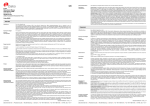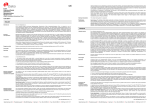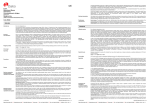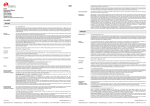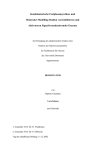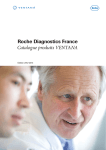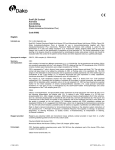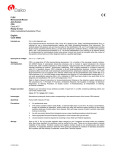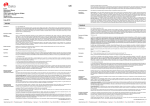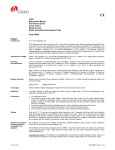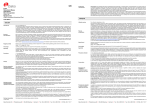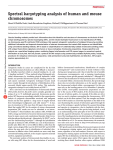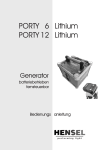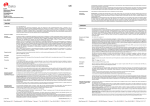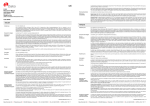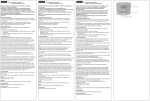Download FLEX Monoclonal Mouse Anti-Human CD79α Clone JCB117
Transcript
Counterstaining in hematoxylin is recommended using EnVision FLEX Hematoxylin, (Dako Autostainer/Autostainer Plus) (Code K8018). Non-aqueous, permanent mounting medium is recommended. Positive and negative controls should be run simultaneously using the same protocol as the patient specimens. The positive control tissue should include tonsil and the cells/structures should display reaction patterns as described for this tissue in “Performance characteristics” in all positive specimens. The recommended negative control reagent is FLEX Negative Control, Mouse, (Dako Autostainer/Autostainer Plus) (Code IS750). FLEX Monoclonal Mouse Anti-Human CD79α α Clone JCB117 Ready-to-use (Dako Autostainer/Autostainer Plus) Staining interpretation Cells labeled by the antibody display membrane and/or cytoplasmic staining. Performance characteristics Normal tissues: Normal plasma cells in tissue samples are strongly positive with the antibody (1). In tonsil the antibody strongly labels cells present in T-cell areas. B cells in the mantle zone of tonsil show a moderate to strong staining reaction, whereas B cells in the germinal centers of tonsil show a weak to moderate staining reaction. Abnormal tissues: The antibody labeled all of 331 B-cell neoplasms, including 41 lymphoblastic lymphomas/leukemias, 28 small lymphocytic, 36 lymphoplasmacytoid, 17 mantle cell, 53 follicular, 29 MALT, 95 large cell, and 7 Burkitt’s lymphomas. Additionally, 15/15 hairy cell leukemias, 13/15 B-cell anaplastic large cell lymphomas, and 10/20 myelomas/plasmacytomas were positive with the antibody. In the same study all of 98 T-cell and non-lymphoid neoplasms were negative with the antibody, including 9 T-cell lymphoblastic lymphomas/leukemias, 10 mycosis fungoides, 32 peripheral T-cell lymphomas, 8 angioblastic T-cell lymphomas, 11 T-cell anaplastic large cell lymphomas, and 28 acute myeloid leukemias (1). Two later studies (5, 6) have shown positive reaction with T-cell neoplasms. Thus, in 149 cases of CD3+ T-(precursor) acute lymphoblastic leukemia/lymphoma, 14 cases expressed CD79α on more than 90% of the blast cells as determined with the antibody. In 55 cases 10-90% of the blast cells were positive (5). Further, in 4/94 of enteropathy-type intestinal - cell lymphomas and 1/11 nasal NK/T-cell lymphomas which were CD3+, the majority of tumor cells were labeled by the antibody (6). Code IS621 ENGLISH For in vitro diagnostic use. Intended use Of 149 cases of T lymphoblastic leukemia/lymphoma, 10% showed sufficiently extensive CD79α labeling with the antibody (more than 90% positive cells) to cause diagnostic problems in distinguishing between B- and T-cell neoplasms. All of the 149 T-cell neoplasms were, however, positive for the Tcell marker CD3, while none of 68 cases of B- lymphoblastic leukemia/lymphoma were CD3-positive (5). FLEX Monoclonal Mouse Anti-Human CD79α, Clone JCB117, Ready-to-Use, (Dako Autostainer/Autostainer Plus), is intended for use in immunohistochemistry together with Dako Autostainer/Autostainer Plus instruments. This antibody labels B cells and is useful for the identification of Bcell neoplasms of all maturation stages (1). The clinical interpretation of any staining or its absence should be complemented by morphological studies using proper controls and should be evaluated within the context of the patient's clinical history and other diagnostic tests by a qualified pathologist. FRANÇAIS Synonyms for antigen Ig-α, mb-1 (2). Summary and explanation CD79 is a disulphide-linked transmembrane heterodimer with a molecular mass of 82-95 kDa belonging to the immunoglobulin superfamily. It comprises the two glycoproteins, CD79α, with a molecular mass of 40-45 kDa, and CD79β, with a molecular mass of 37 kDa. CD79 is non-covalently associated with surface Ig, forming the B-cell receptor complex, which is required for antigen recognition. CD79 is essential for efficient surface expression of the B-cell receptor, and is also necessary for signal transmission into the cytoplasm following antigen-binding to surface Ig. The cytoplasmic portion of CD79α and CD79β contains several kinases. Phosphorylation signals via these kinases result in B-cell activation, differentiation and, in some cases, apoptosis (2, 3, 4). The expression of CD79 is largely restricted to B-linage cells, but CD79α is coexpressed with CD3 in a proportion of T-lymphoblastic leukaemia/lymphoma (5). In precursor B cells, the CD79 protein chains are already expressed in the cytoplasm (CyCD79). Surface expression of CD79 begins at the pro-B-cell stage and persists throughout the B-cell differentiation. CD79α is more strongly expressed by B cells in the follicular mantle zone than by germinal centre B cells, suggesting that activation of mature B cells downregulates CD79 expression. CD79 expression ceases around the onset of plasma cell differentiation, with only a proportion of plasma cells containing CD79 (2, 4). Refer to Dako’s General Instructions for Immunohistochemical Staining or the detection system instructions of IHC procedures for: 1) Principle of Procedure, 2) Materials Required, Not Supplied, 3) Storage, 4) Specimen Preparation, 5) Staining Procedure, 6) Quality Control, 7) Troubleshooting, 8) Interpretation of Staining, 9) General Limitations. Reagent provided Ready-to-use monoclonal mouse antibody provided in liquid form in a buffer containing stabilizing protein and 0.015 mol/L sodium azide. Clone: JCB117 (1). Isotype: IgG1, kappa. Immunogen Recombinant protein containing part of the extracellular portion of the human CD79α glycoprotein (1). Specificity Anti-Human CD79α, clone JCB117, was clustered as anti-CD79α at the Sixth International Workshop and Conference on Human Leucocyte Differentiation Antigens held in Kobe in 1996 (4). FLEX Monoclonal Mouse Anti-Human CD79α, Clone JCB117, Ready-to-Use, (Dako Autostainer/Autostainer Plus) est destiné à une utilisation en immunohistochimie avec les instruments Dako Autostainer/Autostainer Plus. Cet anticorps marque les lymphocytes B et facilite l’identification des néoplasmes à lymphocytes B à tous les stades de maturation (1). L’interprétation clinique de toute coloration ou son absence doit être complétée par des études morphologiques en utilisant des contrôles appropriés et doit être évaluée en fonction des antécédents cliniques du patient et d’autres tests diagnostiques par un pathologiste qualifié. Synonymes de l’antigène Ig-α, mb-1 (2). Résumé et explication La CD79 est un hétérodimère transmembranaire à liaison disulfure dont la masse moléculaire est de 82–95 kDa et qui appartient à la superfamille des immunoglobulines. Elle se compose de deux glycoprotéines, CD79α, de masse moléculaire 40–45 kDa, et CD79β, de masse moléculaire 37 kDa. La CD79 est associée de manière non covalente avec l’Ig de surface, formant le complexe du récepteur des lymphocytes B, qui est nécessaire à la reconnaissance de l’antigène. La CD79 est essentielle à l’expression de surface efficace du récepteur des lymphocytes B, et est également nécessaire à la transmission du signal vers le cytoplasme après la liaison de l’antigène à l’Ig de surface. La partie cytoplasmique de la CD79α et de la CD79β contient plusieurs kinases. Les signaux de phosphorylation via ces kinases entraînent l’activation des lymphocytes B, la différenciation et, dans certains cas, l’apoptose (2, 3, 4). L’expression de la CD79 est largement limitée aux cellules de la lignée B mais la CD79α est coexprimée avec la CD3 dans un certain pourcentage de lymphomes/leucémies à lymphoblastes T (5). Dans les lymphocytes B précurseurs, les chaînes de la protéine CD79 sont déjà exprimées dans le cytoplasme (CyCD79). L’expression de surface de la CD79 commence au stade des cellules pro-B et persiste tout au long de la différenciation des lymphocytes B. La CD79α est plus fortement exprimée par les lymphocytes B dans la zone du manteau folliculaire que par les lymphocytes B des centres germinatifs, ce qui laisse penser que l’activation de lymphocytes B matures régule l’expression de la CD79 à la baisse. L’expression de la CD79 cesse lors du début de la différenciation cellulaire plasmatique, avec seulement une partie des cellules plasmatiques qui contiennent la CD79 (2, 4). Se référer aux Instructions générales de coloration immunohistochimique de Dako ou aux instructions du système de détection relatives aux procédures IHC pour plus d’informations concernant les points suivants : 1) Principe de procédure, 2) Matériels requis mais non fournis, 3) Conservation, 4) Préparation des échantillons, 5) Procédure de coloration, 6) Contrôle qualité, 7) Dépannage, 8) Interprétation de la coloration, 9) Limites générales. In Western blotting of Ramos B-cell lysate, the antibody labels a band corresponding to CD79α under reducing conditions, and a band corresponding to CD79αβ under non-reducing conditions (1). SDS-PAGE analysis of immunoprecipitates formed between the antibody and 125I-labeled, mildly denatured, and reduced lysate of Ramos B cells, shows weak reaction with a 43 kDa polypeptide corresponding to CD79α. 1. For professional users. 2. This product contains sodium azide (NaN3), a chemical highly toxic in pure form. At product concentrations, though not classified as hazardous, sodium azide may react with lead and copper plumbing to form highly explosive build-ups of metal azides. Upon disposal, flush with large volumes of water to prevent metal azide build-up in plumbing. 3. As with any product derived from biological sources, proper handling procedures should be used. 4. Wear appropriate Personal Protective Equipment to avoid contact with eyes and skin. 5. Unused solution should be disposed of according to local, State and Federal regulations. Precautions Storage Store at 2-8 °C. Do not use after expiration date sta mped on vial. If reagents are stored under any conditions other than those specified, the conditions must be verified by the user. There are no obvious signs to indicate instability of this product. Therefore, positive and negative controls should be run simultaneously with patient specimens. If unexpected staining is observed which cannot be explained by variations in laboratory procedures and a problem with the antibody is suspected, contact Dako Technical Support. Specimen preparation including materials required but not supplied The antibody can be used for labeling formalin-fixed, paraffin-embedded tissue sections. Tissue specimens should be cut into sections of approximately 4 µm. Pre-treatment with heat-induced epitope retrieval (HIER) is required using Dako PT Link (Code PT100/PT101). For details, please refer to the PT Link User Guide. Optimal results are obtained by pretreating tissues using EnVision FLEX Target Retrieval Solution, High pH (50x) (Code K8010/K8004). Paraffin-embedded sections: Pre-treatment of formalin-fixed, paraffin-embedded tissue sections is recommended using the 3-in-1 specimen preparation procedure for Dako PT Link. Follow the pre-treatment procedure outlined in the package insert for EnVision FLEX Target Retrieval Solution, High pH (50x) (Code K8010/K8004). Note: After staining the sections must be dehydrated, cleared and mounted using permanent mounting medium. Deparaffinized sections: Pre-treatment of deparaffinized formalin-fixed, paraffin-embedded tissue sections is recommended using Dako PT Link and following the same procedure as described for paraffin-embedded sections. After staining the slides should be mounted using aqueous or permanent mounting medium. The tissue sections should not dry out during the treatment or during the following immunohistochemical staining procedure. For greater adherence of tissue sections to glass slides, the use of FLEX IHC Microscope Slides (Code K8020) is recommended. Staining procedure including materials required but not supplied The recommended visualization system is EnVision FLEX, High pH, (Dako Autostainer/Autostainer Plus) (Code K8010). The staining steps and incubation times are pre-programmed into the software of Dako Autostainer/Autostainer Plus instruments, using the following protocols: Template protocol: FLEXRTU2 (200 µL dispense volume) or FLEXRTU3 (300 µL dispense volume) Autoprogram: CD79 (without counterstaining) or CD79H (with counterstaining) Réactifs fournis Anticorps monoclonal de souris prêt à l’emploi fourni sous forme liquide dans un tampon contenant une protéine stabilisante et 0,015 mol/L d’azide de sodium. Clone : JCB117 (1). Isotype : IgG1, kappa. Immunogène Protéine recombinante contenant une partie de la portion extracellulaire de la glycoprotéine CD79α humaine (1). Spécificité Anti-Human CD79α, clone JCB117, a été classé comme un anti-CD79α à la Sixth International Workshop and Conference on Human Leucocyte Differentiation Antigens (Sixième Conférence et Atelier Internationaux sur les Antigènes de Différenciation des Leucocytes Humains (HLDA)) en 1996 (4). Dans les analyses par Western blot de lysat de lymphocytes B Ramos, l’anticorps marque une bande correspondant à la CD79α dans des conditions réductrices, et une bande correspondant à la CD79αβ dans des conditions non réductrices (1). L’analyse par immunoblot PAGE en présence de SDS d’immunoprécipités formés entre l’anticorps et marqués à l’iode 125I, légèrement dénaturée, et un lysat réduit de lymphocytes B Ramos, a montré une faible réaction avec un polypeptide de 43 kDa correspondant à la CD79α. Précautions 1. Pour utilisateurs professionnels. 2. Ce produit contient de l’azide de sodium (NaN3), produit chimique hautement toxique dans sa forme pure. Aux concentrations du produit, bien que non classé comme dangereux, l’azide de sodium peut réagir avec le cuivre et le plomb des canalisations et former des accumulations d’azides métalliques hautement explosifs. Lors de l’élimination, rincer abondamment à l’eau pour éviter toute accumulation d’azide métallique dans les canalisations. 3. Comme avec tout produit d’origine biologique, des procédures de manipulation appropriées doivent être respectées. 4. Porter un vêtement de protection approprié pour éviter le contact avec les yeux et la peau. 5. Les solutions non utilisées doivent être éliminées conformément aux réglementations locales et nationales. Conservation Conserver entre 2 et 8 °C. Ne pas utiliser après la date de péremption indiquée sur le flacon. Si les réactifs sont conservés dans des conditions autres que celles indiquées, celles-ci doivent être validées par l’utilisateur. Il n’y a aucun signe évident indiquant l’instabilité de ce produit. Par conséquent, des contrôles positifs et négatifs doivent être testés en même temps que les échantillons de patient. Si une coloration inattendue est observée, qui ne peut être expliquée par un changement des procédures du laboratoire, et en cas de suspicion d’un problème lié à l’anticorps, contacter l’assistance technique de Dako. Préparation des échantillons y compris le matériel requis mais non fourni L’anticorps peut être utilisé pour le marquage des coupes de tissus inclus en paraffine et fixés au formol. L’épaisseur des coupes d’échantillons de tissu doit être d’environ 4 µm. Un prétraitement avec démasquage d’épitope induit par la chaleur (HIER) est nécessaire avec le Dako PT Link (Réf. PT100/PT101). Pour plus de détails, se référer au Guide d’utilisation du PT Link. Des résultats optimaux sont obtenus en prétraitant les tissus à l’aide de la EnVision FLEX Target Retrieval Solution, High pH (50x) (Réf. K8010/K8004). Coupes incluses en paraffine : le prétraitement des coupes tissulaires fixées au formol et incluses en paraffine est recommandé à l'aide de la procédure de préparation d'échantillon 3-en-un pour le Dako PT Link. Suivre la procédure de prétraitement indiquée dans la notice de la EnVision FLEX Target Retrieval Solution, High pH (50x) (Réf. K8010/K8004). Remarque : après coloration, les coupes doivent être déshydratées, lavées et montées à l’aide d’un milieu de montage permanent. Coupes déparaffinées : le prétraitement des coupes tissulaires déparaffinées, fixées au formol et incluses en paraffine, est recommandé à l’aide du Dako PT Link, en suivant la même procédure que pour les coupes incluses en paraffine. Après coloration, un montage aqueux ou permanent des lames est recommandé. Les coupes de tissus ne doivent pas sécher lors du traitement ni lors de la procédure de coloration immunohistochimique suivante. Pour une meilleure adhérence des coupes de tissus sur les lames de verre, il est recommandé d’utiliser des lames FLEX IHC Microscope Slides (Réf. K8020). The Auxiliary step should be set to “rinse buffer” in staining runs with ≤10 slides. For staining runs with >10 slides the Auxiliary step should be set to “none”. This ascertains comparable wash times. All incubation steps should be performed at room temperature. For details, please refer to the Operator’s Manual for the dedicated instrument. If the protocols are not available on the used Dako Autostainer instrument, please contact Dako Technical Services. Optimal conditions may vary depending on specimen and preparation methods, and should be determined by each individual laboratory. If the evaluating pathologist should desire a different staining intensity, a Dako Application Specialist/Technical Service Specialist can be contacted for information on reprogramming of the protocol. Verify that the performance of the adjusted protocol is still valid by evaluating that the staining pattern is identical to the staining pattern described in “Performance characteristics”. (115260-003) Dako Denmark A/S IS621/EFG/MNI/2009.12.04 p. 1/4 | Produktionsvej 42 | DK-2600 Glostrup | Denmark | Tel. +45 44 85 95 00 | Fax +45 44 85 95 95 | CVR No. 33 21 13 17 Pour utilisation diagnostique in vitro. Utilisation prévue (115260-003) Dako Denmark A/S IS621/EFG/MNI/2009.12.04 p. 2/4 | Produktionsvej 42 | DK-2600 Glostrup | Denmark | Tel. +45 44 85 95 00 | Fax +45 44 85 95 95 | CVR No. 33 21 13 17 Procédure de coloration y compris le matériel requis mais non fourni Le système de visualisation recommandé est le EnVision FLEX, High pH, (Dako Autostainer/Autostainer Plus) (Réf. K8010). Les étapes de coloration et d’incubation sont préprogrammées dans le logiciel des instruments Dako Autostainer/Autostainer Plus, à l’aide des protocoles suivants : Protocole modèle : FLEXRTU2 (volume de distribution de 200 µL) ou FLEXRTU3 (volume de distribution de 300 µL) Autoprogram : CD79 (sans contre-coloration) ou CD79H (avec contre-coloration) L’étape Auxiliary doit être réglée sur « rinse buffer » lors des cycles de coloration avec ≤10 lames. Pour les cycles de coloration de >10 lames, l’étape Auxiliary doit être réglée sur « none ». Cela garantit des temps de lavage comparables. Toutes les étapes d’incubation doivent être effectuées à température ambiante. Pour plus de détails, se référer au Manuel de l’opérateur spécifique à l'instrument. Si les protocoles ne sont pas disponibles sur l’instrument Dako Autostainer utilisé, contacter le service technique de Dako. Les conditions optimales peuvent varier en fonction du prélèvement et des méthodes de préparation, et doivent être déterminées par chaque laboratoire individuellement. Si le pathologiste qui réalise l’évaluation désire une intensité de coloration différente, un spécialiste d’application/spécialiste du service technique de Dako peut être contacté pour obtenir des informations sur la re-programmation du protocole. Vérifier que l'exécution du protocole modifié est toujours valide en vérifiant que le schéma de coloration est identique au schéma de coloration décrit dans les « Caractéristiques de performance ». Lagerung Bei 2–8 °C aufbewahren. Nach Ablauf des auf dem Fläschch en aufgedruckten Verfalldatums nicht mehr verwenden. Werden die Reagenzien unter anderen als den angegebenen Bedingungen aufbewahrt, müssen diese Bedingungen vom Benutzer validiert werden. Es gibt keine offensichtlichen Anzeichen für eine eventuelle Produktinstabilität. Positiv- und Negativkontrollen sollten daher zur gleichen Zeit wie die Patientenproben getestet werden. Falls es zu einer unerwarteten Färbung kommt, die sich nicht durch Unterschiede bei Laborverfahren erklären lässt und auf ein Problem mit dem Antikörper hindeutet, ist der technische Kundendienst von Dako zu verständigen. Vorbereitung der Probe und erforderliche, aber nicht mitgelieferte Materialien Der Antikörper eignet sich zur Markierung von formalinfixierten und paraffineingebetteten Gewebeschnitten. Gewebeproben sollten in Schnitte von ca. 4 µm Stärke geschnitten werden. Die Vorbehandlung durch hitzeinduzierte Epitopdemaskierung (HIER) mit Dako PT Link (Code-Nr. PT100/PT101) ist erforderlich. Weitere Informationen hierzu siehe PT Link-Benutzerhandbuch. Optimale Ergebnisse können durch Vorbehandlung der Gewebe mit EnVision FLEX Target Retrieval Solution, High pH (50x) (Code-Nr. K8010/K8004) erzielt werden. Paraffineingebettete Schnitte: Die Vorbehandlung der formalinfixierten, paraffineingebetteten Schnitte mit dem 3-in-1-Probenvorbereitungsverfahren für Dako PT Link wird empfohlen. Vorbehandlung gemäß der Beschreibung in der Packungsbeilage für EnVision FLEX Target Retrieval Solution, High pH (50x) (Code-Nr. K8010/K8004) durchführen. Hinweis: Nach dem Färben müssen die Schnitte dehydriert, geklärt und mit permanentem Einbettmedium auf den Objektträger aufgebracht werden. Entparaffinierte Schnitte: Eine Vorbehandlung der entparaffinierten, formalinfixierten, paraffineingebetteten Gewebeschnitte mit Dako PT Link nach demselben Verfahren, wie für die paraffineingebetteten Schnitte beschrieben, wird empfohlen. Die Objektträger nach dem Färben mit einem wässrigen oder permanenten Einbettmedium bedecken. Die Gewebeschnitte dürfen während der Behandlung oder des anschließenden immunhistochemischen Färbeverfahrens nicht austrocknen. Zur besseren Haftung der Gewebeschnitte an den Glasobjektträgern wird die Verwendung von FLEX IHC Microscope Slides (Code-Nr. K8020) empfohlen. Färbeverfahren und erforderliche, aber nicht mitgelieferte Materialien Das empfohlene Visualisierungssystem ist EnVision™ FLEX, High pH (Dako Autostainer/Autostainer Plus)(Code-Nr. K8010). Die Färbeschritte und Inkubationszeiten sind in der Software der Dako Autostainer/Autostainer Plus-Geräte mit den folgenden Protokollen vorprogrammiert: Matrix-Protokoll: FLEXRTU2 (200 µL Abgabevolumen) oder FLEXRTU3 (300 µL Abgabevolumen) Autoprogram: CD79 (ohne Gegenfärbung) oder CD79H (mit Gegenfärbung) Bei Färbedurchläufen mit höchstens 10 Objektträgern sollte der „Zusatz“-Schritt auf „Pufferspülgang“ eingestellt werden. Für Färbedurchläufe mit mehr als 10 Objektträgern den „Zusatz“-Schritt auf „Keine“ einstellen. Dieses gewährleistet vergleichbare Waschzeiten. Alle Inkubationsschritte sollten bei Raumtemperatur durchgeführt werden. Nähere Einzelheiten bitte dem Benutzerhandbuch für das jeweilige Gerät entnehmen. Wenn die Färbeprotokolle auf dem verwendeten Dako Autostainer-Gerät nicht verfügbar sind, bitte den Technischen Kundendienst von Dako verständigen. Optimale Bedingungen können je nach Probe und Präparationsverfahren unterschiedlich sein und sollten vom jeweiligen Labor selbst ermittelt werden. Falls der beurteilende Pathologe eine andere Färbungsintensität wünscht, kann ein Anwendungsspezialist oder Kundendiensttechniker von Dako bei der Neuprogrammierung des Protokolls helfen. Die Leistung des angepassten Protokolls muss verifiziert werden, indem gewährleistet wird, dass das Färbemuster mit dem unter „Leistungsmerkmale“ beschriebenen Färbemuster identisch ist. Die Gegenfärbung in Hämatoxylin sollte mit EnVision™ FLEX Hematoxylin, (Dako Autostainer/Autostainer Plus) (Code-Nr. K8018) ausgeführt werden. Empfohlen wird ein nichtwässriges, permanentes Fixiermittel. Positiv- und Negativkontrollen sollten zur gleichen Zeit und mit demselben Protokoll wie die Patientenproben getestet werden. Das positive Kontrollgewebe sollte Mandelgewebe enthalten und die Zellen/Strukturen müssen in allen positiven Proben die für dieses Gewebe unter „Leistungsmerkmale“ beschriebenen Reaktionsmuster aufweisen. Das empfohlene Negativ-Kontrollreagenz ist FLEX Negative Control, Mouse, (Dako Autostainer/Autostainer Plus) (Code-Nr. IS750). Auswertung der Färbung Mit diesem Antikörper markierte Zellen weisen eine zytoplasmatische und/oder membranöse Färbung auf. Leistungsmerkmale Gesundes Gewebe: Normale Plasmazellen in Gewebeproben reagieren mit dem Antikörper stark positiv (1). In Mandelgewebe markiert der Antikörper in starkem Ausmaß B-Zellen in T-Zellbereichen. Die B-Zellen in der Mantelzone von Mandelgewebe zeigen eine mäßige bis starke Färbereaktion, während B-Zellen in den Keimzentren von Mandelgewebe eine schwache bis mäßige Färbereaktion aufweisen. Pathologisches Gewebe: Der Antikörper markierte alle 331 B-Zellneoplasmen, einschließlich 41 lymphoblastische Lymphome/Leukämien, 28 kleine Lymphozyten, 36 Lymphoplasmazytoiden, 17 Mantelzellen, 53 follikuläre, 29 MALT-, 95 großzellige und 7 Burkitt-Lymphome. Darüber hinaus waren 15 von 15 Haarzellleukämien, 13 von 15 anaplastischen großzelligen B-Zelllymphomen und 10 von 20 Myelomen/Plasmazytomen mit dem Antikörper positiv. In der gleichen Studie waren alle 98 T-Zell- und nicht-lymphoiden Neoplasmen mit dem Antikörper negativ, darunter auch 9 T-Zelllymphoblastische Lymphome/Leukämien, 10 Mycosis fungoides, 32 periphere T-Zelllymphome, 8 angioblastische T-Zelllymphome, 11 T-Zellanaplastische großzellige Lymphome und 28 akute myeloide Leukämien (1). Zwei spätere Studien (5, 6) haben eine positive Reaktion mit TZellneoplasmen gezeigt. Somit wurde mit Hilfe des Antikörpers gezeigt, dass von den 149 CD3-positiven Fällen von T-(Vorläufer)-akuter lymphoblastischer Leukämie/lymphoblastischem Lymphom in 14 Fällen CD79α auf mehr als 90 % der Blastzellen exprimiert wurde. In 55 Fällen waren 10–90 % der Blastzellen positiv (5). Darüber hinaus wurde in 4 von 94 intestinalen T-Zelllymphomen vom enteropathischen Typ und in 1 von 11 nasalen CD3-positiven NK/T-Zelllymphomen die Mehrheit der Tumorzellen durch den Antikörper markiert (6). Von 149 Fällen von T-lymphoblastischer Leukämie/lymphoblastischem Lymphom zeigten 10 % eine ausreichend extensive CD79α-Markierung mit dem Antikörper (mehr als 90 % positive Zellen), um diagnostische Probleme bei der Unterscheidung zwischen B- und T-Zellneoplasmen zu verursachen. Alle der 149 T-Zellneoplasmen waren jedoch positiv für den T-Zellmarker CD3, während keiner von 68 Fällen der lymphoblastischen Leukämien/Lymphome CD3-positiv war (5). Il est recommandé d’effectuer une contre-coloration à l’aide de EnVision FLEX Hematoxylin, (Dako Autostainer/Autostainer Plus) (Réf. K8018). L’utilisation d’un milieu de montage permanent non aqueux est recommandée. Des contrôles positifs et négatifs doivent être réalisés en même temps et avec le même protocole que les échantillons du patient. Le contrôle de tissu positif doit comprendre l’amygdale et les cellules/structures doivent présenter des schémas de réaction tels que décrits pour ces tissus dans les « Caractéristiques de performance » pour tous les échantillons positifs. Le contrôle négatif recommandé est le FLEX Negative Control, Mouse, (Dako Autostainer/Autostainer Plus) (Réf. IS750). Interprétation de la coloration Les cellules marquées par l’anticorps présentent une coloration cytoplasmique et/ou membranaire. Caractéristiques de performance Tissus sains : Les cellules plasmatiques normales dans les échantillons de tissus sont fortement positives à l’anticorps (1). Dans l’amygdale, l’anticorps marque fortement les cellules présentes dans les zones des lymphocytes T. Les lymphocytes B de la zone du manteau des amygdales présentent une coloration modérée à forte, tandis que la coloration des lymphocytes B des centres germinatifs des amygdales est faible à modérée. Tissus tumoraux : L’anticorps a marqué chacun des 331 néoplasmes à lymphocytes B, dont 41 cas de lymphomes/leucémies à lymphoblastes, 28 lymphomes lymphocytaires à petites cellules, 36 lymphomes lymphoplasmacytoïdes, 17 lymphomes à cellules du manteau, 53 lymphomes folliculaires, 29 cas de MALT, 95 lymphomes à grandes cellules et 7 lymphomes de Burkitt. De plus, 15 cas de leucémies à cellules chevelues sur 15, 13 cas de lymphomes anaplasiques à grands lymphocytes B sur 15 et 10 cas de myélomes/plasmocytomes sur 20 étaient positifs à l’anticorps. Au cours de la même étude, chacun des 98 néoplasmes non lymphoïdes et à lymphocytes T étaient négatifs à l’anticorps, dont 9 cas de lymphome/leucémie à lymphoblastes T, 10 mycoses fongoïdes, 32 lymphomes périphériques à lymphocytes T, 8 lymphomes angioblastiques à lymphocytes T, 11 lymphomes anaplasiques à grands lymphocytes T et 28 leucémies myéloïdes aiguës (1). Deux études postérieures (5, 6) ont montré une réaction positive avec les néoplasmes à lymphocytes T. Ainsi, dans 149 cas de lymphomes/leucémies lymphoblastiques aiguës à précurseurs des lymphocytes T positifs à la CD3, 14 cas ont exprimé la CD79α sur plus de 90 % des blastocytes tel que déterminé par l’anticorps. Dans 55 cas, de 10 à 90 % des blastocytes étaient positifs (5). De plus, dans 4 cas sur 94 de lymphome à lymphocytes T intestinal de type entéropathique et dans 1 cas sur 11 de lymphome à lymphocytes T/NK nasal qui étaient positifs à la CD3, la majorité des cellules tumorales étaient marquées par l’anticorps (6). Dans 149 cas de lymphomes/leucémies à lymphoblastes T, 10 % ont présenté un marquage suffisamment important de la CD79α par l’anticorps (plus de 90 % de cellules positives) pour entraîner des problèmes de diagnostic liés à la distinction des néoplasmes à lymphocytes B et T. Cependant, chacun des 149 cas de néoplasmes à lymphocytes T s’est avéré positif au marqueur des lymphocytes T, à savoir la CD3, alors qu’aucun des 68 cas de lymphomes/leucémies lymphoblastiques à lymphocytes B n’était positif à la CD3 (5). DEUTSCH Zur In-vitro-Diagnostik. Zweckbestimmung FLEX Monoclonal Mouse Anti-Human CD79α, Clone JCB117, Ready-to-Use, (Dako Autostainer/Autostainer Plus) ist zur Verwendung in der Immunhistochemie in Verbindung mit Dako Autostainer/Autostainer Plus-Geräten bestimmt. Dieser Antikörper markiert B-Zellen und dient zur Identifizierung von B-Zellen-Neoplasmen aller Reifestadien (1). Die klinische Auswertung einer eventuell eintretenden Färbung sollte durch morphologische Studien mit ordnungsgemäßen Kontrollen ergänzt werden und von einem qualifizierten Pathologen unter Berücksichtigung der Krankengeschichte und anderer Diagnostiktests des Patienten vorgenommen werden. Synonyme für das Antigen Ig-α, mb-1 (2). Zusammenfassung und Erklärung CD79 ist ein über Disulfid-Brücken verbundenes Transmembran-Heterodimer mit einem Molekulargewicht von 82–95 kDa und gehört zur Superfamilie der Immunglobuline. Es umfasst die beiden Glykoproteine CD79α, mit einem Molekulargewicht von 40–45 kDa, und CD79β mit einem Molekulargewicht von 37 kDa. CD79 ist nicht-kovalent mit dem Oberflächen-Ig verbunden. Dabei entsteht der B-Zellen-Rezeptorkomplex, der für die Antigenerkennung erforderlich ist. CD79 ist für eine effiziente Oberflächenexpression des B-Zellrezeptors unerlässlich und ist ebenfalls notwendig bei der Signalübertragung in das Zytoplasma nach Bindung des Antigens an Oberflächen-Ig. Der zytoplasmatische Anteil von CD79α und CD79β enthält mehrere Kinasen. Phosphorylierungssignale über diese Kinasen führen zu B-Zellen-Aktivierung, Differenzierung und in einigen Fällen Apoptose (2, 3, 4). Die Expression von CD79 ist weitgehend auf Zellen der B-Zelllinie beschränkt, CD79α wird jedoch mit CD3 ko-exprimiert, wobei das Verhältnis dem von T-lymphoblastischer Leukämie/T-lymphoblastischen Lymphom entspricht (5). In Vorläufer-B-Zellen werden die CD79-Proteinketten bereits im Zytoplasma exprimiert (CyCD79). Die Oberflächenexpression von CD79 beginnt während der Pro-B-Zell-Phase und dauert während der gesamten BZelldifferenzierung an. CD79α wird von B-Zellen in der follikulären Mantelzone stärker exprimiert als von B-Zellen des Keimzentrums, was darauf hinweist, dass die Aktivierung reifer B-Zellen die CD79-Expression herunterreguliert. Die CD79-Expression wird zu Beginn der Plasmazelldifferenzierung beendet, wobei nur ein Teil der Plasmazellen CD79 enthält (2, 4). Folgende Angaben bitte den Allgemeinen Richtlinien zur immunhistochemischen Färbung von Dako oder den Anweisungen des Detektionssystems für IHC-Verfahren entnehmen: 1) Verfahrensprinzip, 2) Erforderliche, aber nicht mitgelieferte Materialien, 3) Aufbewahrung, 4) Vorbereitung der Probe, 5) Färbeverfahren, 6) Qualitätskontrolle, 7) Fehlersuche und -behebung, 8) Auswertung der Färbung, 9) Allgemeine Beschränkungen. Geliefertes Reagenz Gebrauchsfertiger, monoklonaler Maus-Antikörper in flüssiger Form in einem Puffer, der stabilisierendes Protein und 0,015 mol/L Natriumazid enthält. Klon: JCB117 (1). Isotyp: IgG1, Kappa. Immunogen Rekombinantes Protein, das einen Teil der extrazellulären Domäne des menschlichen CD79α-Glykoproteins enthält (1). Spezifität Anti-Human CD79α, Clone JCB117 wurde bei dem/der 6th International Workshop and Conference on Human Leucocyte Differentiation Antigens (6. Internationale(r) Workshop und Konferenz über menschliche Leukozyten differenzierende Antigene) in Kobe im Jahr 1966 als Anti-CD79α geclustert (4). References/ Références/ Literatur 1. 2. 3. 4. 5. 6. Mason DY, Cordell JL, Brown MH, Borst J, Jones M, Pulford K, et al. CD79α: a novel marker for B-cell neoplasms in routinely processed tissue samples. Blood 1995;86:1453-9. Comans-Bitter WM, De Bruin-Versteeg S, Broe MK, De Groot R, De Vries E, Van Dongen JJM. BC20.1. CD79 workshop: intracellular CD79 expression in precursor B cells tested with the CD79 panel of monoclonal antibodies. In: Kishimoto T, Kikutani H, von dem Borne AEG, Goyert SM, Mason DY, Miyasaka M, et al., editors. Leucocyte typing VI. White cell differentiation antigens. Proceedings of the 6th International Workshop and Conference; 1996 Nov 10-14; Kobe, Japan. New York, London: Garland Publishing Inc.; 1997. p. 182-4. Nakamura T. CD guide. CD79α and CD79β. In: Kishimoto T, Kikutani H, von dem Borne AEG, Goyert SM, Mason DY, Miyasaka M, et al., editors. Leucocyte typing VI. White cell differentiation antigens. Proceedings of the 6th International Workshop and Conference; 1996 Nov 10-14; Kobe, Japan. New York, London: Garland Publishing Inc.; 1997. p. 1172. Nakamura T. BC20. CD79 workshop panel report. In: Kishimoto T, Kikutani H, von dem Borne AEG, Goyert SM, Mason DY, Miyasaka M, et al., editors. Leucocyte typing VI. White cell differentiation antigens. Proceedings of the 6th International Workshop and Conference; 1996 Nov 10-14; Kobe, Japan. New York, London: Garland Publishing Inc.; 1997. p. 180-2. Pilozzi E, Pulford K, Jones M, Müller-Hermelink H-K, Falini B, Ralfkiaer E, et al. Co-expression of CD79α (JBC117) and CD3 by lymphoblastic lymphoma. J Pathol 1998; 186:140-3. Blakolmer K, Vesely M, Kummer JA, Jurecka W, Mannhalter C, Chott A. Immunoreactivity of B-cell markers (CD79α, L26) in rare cases of extranodal cytotoxic peripheral T- (NK/T-) cell lymphomas. Mod Pathol 2000; 13:766-72. Explanation of symbols/ Explication des symboles/ Erläuterung der Symbole Catalogue number Référence catalogue Bestellnummer Beim Western-Blotting von Ramos-B-Zelllysat markiert der Antikörper unter reduzierten Bedingungen eine CD79α entsprechende Bande und unter nicht reduzierten Bedingungen eine Bande, die CD79αβ entspricht. Die SDS-PAGE-Analyse der Immunpräzipitate, die zwischen dem Antikörper und 125I-markierten, schwach denaturierten und reduzierten Lysaten aus Ramos-B-Zellen entstehen, zeigt eine schwache Reaktion mit einem 43-kDa-Polypeptid, das CD79α entspricht. Vorsichtsmaßnahmen (115260-003) Dako Denmark A/S 1. Nur für Fachpersonal bestimmt. 2. Dieses Produkt enthält Natriumazid (NaN3), eine in reiner Form äußerst giftige Chemikalie. Natriumazid kann auch in als ungefährlich eingestuften Konzentrationen mit Blei- und Kupferrohren reagieren und hochexplosive Metallazide bilden. Nach der Entsorgung stets mit viel Wasser nachspülen, um Metallazidansammlungen in den Leitungen vorzubeugen. 3. Wie alle Produkte biologischen Ursprungs müssen auch diese entsprechend gehandhabt werden. 4. Geeignete Schutzkleidung tragen, um Augen- und Hautkontakt zu vermeiden. 5. Nicht verwendete Lösung ist entsprechend örtlichen, bundesstaatlichen und staatlichen Richtlinien zu entsorgen. IS621/EFG/MNI/2009.12.04 p. 3/4 | Produktionsvej 42 | DK-2600 Glostrup | Denmark | Tel. +45 44 85 95 00 | Fax +45 44 85 95 95 | CVR No. 33 21 13 17 Temperature limitation Limites de température Use by Utiliser avant Zulässiger Temperaturbereich Verwendbar bis In vitro diagnostic medical device Dispositif médical de diagnostic in vitro In-vitro-Diagnostikum Contains sufficient for <n> tests Contenu suffisant pour <n> tests Manufacturer Fabricant Inhalt ausreichend für <n> Tests Hersteller Consult instructions for use Voir les instructions d’utilisation Gebrauchsanweisung beachten Batch code Numéro de lot (115260-003) Dako Denmark A/S Chargenbezeichnung IS621/EFG/MNI/2009.12.04 p. 4/4 | Produktionsvej 42 | DK-2600 Glostrup | Denmark | Tel. +45 44 85 95 00 | Fax +45 44 85 95 95 | CVR No. 33 21 13 17


